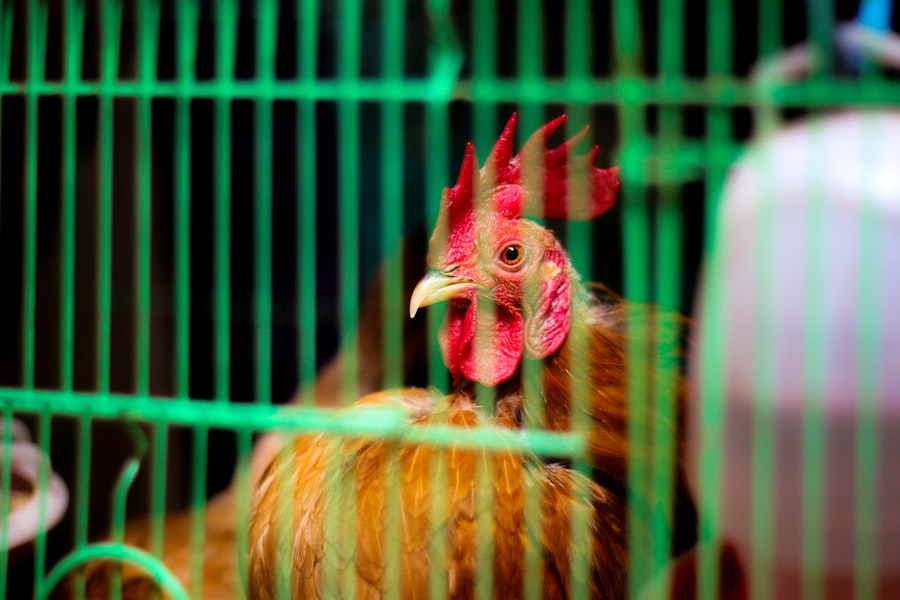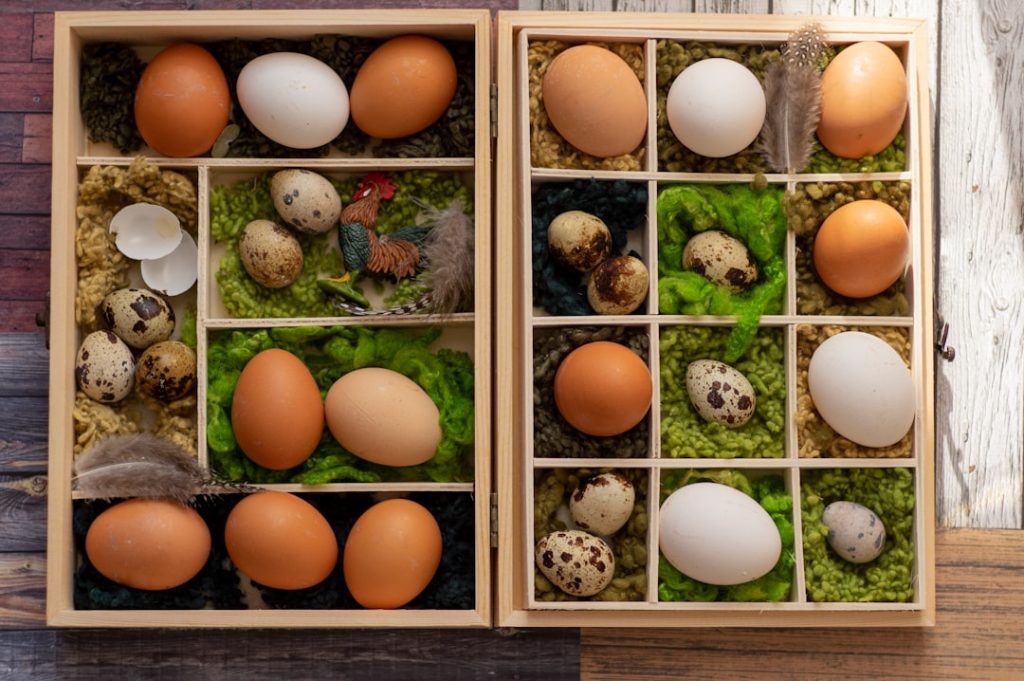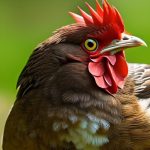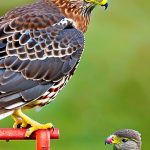Hawks pose a significant threat to free-range chickens, necessitating their identification for effective flock protection. Several hawk species are known to prey on chickens, including Cooper’s hawks, red-tailed hawks, and sharp-shinned hawks. These raptors possess exceptional vision, powerful talons, and agile flight capabilities, making them efficient predators.
Identifying hawks involves recognizing their physical characteristics and behavior. Hawks are typically medium to large birds with broad wings, long tails, hooked beaks, and strong talons. Their hunting behavior often includes soaring at high altitudes before swooping down to capture prey.
Hawk vocalizations are another identifying feature. These birds emit distinctive, high-pitched calls, particularly while in flight. Familiarity with hawk calls can alert chicken keepers to their presence in the vicinity.
Understanding hawk identification methods, including physical traits, hunting patterns, and vocalizations, enables poultry owners to implement appropriate protective measures for their flocks. Constant vigilance and observation are crucial for maintaining chicken safety in areas where hawks are present.
Table of Contents
- 1 Creating Safe Coop and Run Areas for Free Range Chickens
- 2 Utilizing Predator Deterrents and Repellents
- 3 Implementing Visual Deterrents to Ward Off Hawks
- 4 Providing Adequate Cover and Shelter for Free Range Chickens
- 5 Supervising Free Range Chickens During High Risk Times
- 6 Seeking Help from Local Wildlife Authorities for Hawk Management
- 7 FAQs
- 7.1 What are the main threats to free range chickens from hawks?
- 7.2 How can I keep my free range chickens safe from hawks?
- 7.3 What type of overhead cover is best for protecting free range chickens from hawks?
- 7.4 What scare tactics can be effective in deterring hawks from attacking free range chickens?
- 7.5 Are there certain times of day when hawks are more likely to attack free range chickens?
- 7.6 Are there any other predators that pose a threat to free range chickens?
Key Takeaways
- Identify hawks in your area to understand the threat to free range chickens
- Create safe coop and run areas to protect free range chickens from hawk attacks
- Use predator deterrents and repellents to keep hawks away from free range chickens
- Implement visual deterrents to ward off hawks and protect free range chickens
- Provide adequate cover and shelter for free range chickens to hide from hawks and other predators
- Supervise free range chickens during high risk times to ensure their safety from hawks
- Seek help from local wildlife authorities for effective hawk management and protection of free range chickens
Creating Safe Coop and Run Areas for Free Range Chickens
Designing a Secure Coop and Run Area
One of the most effective ways to keep chickens safe from hawks is by providing them with a secure coop and run area. This can help to keep them protected from aerial predators while still allowing them to have access to the outdoors. When designing a coop and run area, it’s important to consider the size and layout in order to provide adequate space for the chickens to move around while also keeping them safe.
Providing Cover and Shelter
In addition to providing a secure coop and run area, it’s important to consider adding cover and shelter to protect chickens from aerial attacks. This can include adding trees, shrubs, or other structures that provide overhead cover and hiding spots for the chickens. By creating a more natural and protected environment, you can help to reduce the risk of hawk attacks on your flock.
Ensuring Predator-Proof Fencing
Another important aspect of creating safe coop and run areas for free-range chickens is ensuring that the fencing is secure and predator-proof. This can help to prevent hawks and other predators from gaining access to the chickens. Using hardware cloth or welded wire fencing with small openings can help to keep hawks out while still allowing the chickens to have access to fresh air and sunlight.
Utilizing Predator Deterrents and Repellents
Utilizing predator deterrents and repellents can be an effective way to protect free-range chickens from hawk attacks. There are several different methods that can be used to deter predators such as hawks from targeting chickens. One common deterrent is the use of scare devices, such as predator decoys, reflective tape, or noise makers.
These can help to startle hawks and other predators, making them less likely to target your flock. Another effective method for deterring predators is the use of motion-activated lights or sprinkler systems. These can help to startle hawks and other predators when they approach the coop or run area, making them less likely to attempt an attack on the chickens.
Additionally, using predator repellents such as chemical sprays or natural deterrents like predator urine can help to create a barrier that deters hawks from targeting your flock. In addition to using scare devices and repellents, it’s important to consider other methods for deterring predators such as hawks. This can include removing potential food sources for predators, such as spilled chicken feed or uncovered garbage that may attract them to your property.
By taking these proactive measures, you can help to reduce the risk of hawk attacks on your free-range chickens and keep them safe from harm.
Implementing Visual Deterrents to Ward Off Hawks
Implementing visual deterrents can be an effective way to ward off hawks and protect free-range chickens from potential attacks. Visual deterrents work by creating an illusion of danger or threat that makes hawks less likely to target your flock. One common visual deterrent is the use of predator eye balloons or scarecrow decoys placed in the coop or run area.
These can help to create the appearance of a larger predator in the area, making hawks less likely to attempt an attack on your chickens. Another effective visual deterrent is the use of reflective objects such as shiny tape or CDs hung around the coop or run area. The reflective surfaces can create flashes of light that startle hawks and make them less likely to approach the area.
Additionally, using predator silhouettes or cutouts placed strategically around the property can create the appearance of a larger predator presence, deterring hawks from targeting your flock. In addition to using visual deterrents, it’s important to consider the placement and rotation of these devices in order to maximize their effectiveness. Moving scare devices and reflective objects around the coop and run area regularly can help to prevent hawks from becoming accustomed to them, increasing their effectiveness as deterrents.
By implementing visual deterrents strategically, you can help to ward off hawks and protect your free-range chickens from potential attacks.
Providing Adequate Cover and Shelter for Free Range Chickens
Providing adequate cover and shelter for free-range chickens is essential for protecting them from hawk attacks. Hawks are known for their aerial hunting abilities, making it important for chickens to have access to cover and shelter where they can hide from potential predators. One way to provide cover for free-range chickens is by planting trees, shrubs, or tall grasses around the coop and run area.
These natural elements can provide overhead cover and hiding spots for chickens when they sense danger from above. In addition to natural cover, it’s important to consider adding structures such as chicken tunnels or covered runs that provide additional protection for free-range chickens. These enclosed areas can give chickens a safe space where they can seek refuge from potential aerial predators like hawks.
Additionally, providing covered feeding areas or shelters within the coop and run area can give chickens a place to escape from potential attacks. Another important aspect of providing adequate cover and shelter for free-range chickens is ensuring that there are multiple escape routes available in case of a hawk attack. This can include adding multiple entrances or exits to the coop and run area, as well as creating hiding spots such as brush piles or rock formations where chickens can seek refuge if they sense danger from above.
By providing adequate cover and shelter for free-range chickens, you can help to reduce the risk of hawk attacks and ensure their safety.
Supervising Free Range Chickens During High Risk Times

Understanding Hawk Behavior
Hawks are known for their hunting behavior during certain times of day, such as early morning or late afternoon when they are most active in searching for prey. By being aware of these high-risk times, you can take proactive measures to supervise your free-range chickens and reduce the risk of potential attacks.
Direct Supervision
One way to supervise free-range chickens during high-risk times is by keeping a close eye on them during early morning and late afternoon when hawks are most active. This can involve spending time outside with the flock or using surveillance cameras to monitor their behavior and keep an eye out for any signs of potential danger from above. By being present during these high-risk times, you can help to deter hawks from targeting your flock.
Physical Barriers for Added Protection
In addition to direct supervision, it’s important to consider using protective measures such as overhead netting or wire mesh covers during high-risk times when hawks are most active. These physical barriers can help to prevent aerial attacks on free-range chickens while still allowing them access to outdoor areas. By supervising free-range chickens during high-risk times and taking proactive measures to protect them, you can help to reduce the risk of hawk attacks and keep your flock safe.
Seeking help from local wildlife authorities can be an important step in managing hawk populations in your area and protecting free-range chickens from potential attacks. Wildlife authorities have knowledge and expertise in dealing with predatory birds such as hawks, and they can provide valuable guidance on how to manage their presence near your property. By reaching out to local wildlife authorities, you can gain insight into legal methods for managing hawk populations while still protecting these important birds of prey.
One way that local wildlife authorities can assist with hawk management is by providing information on legal deterrent methods that can be used to protect free-range chickens without harming hawks or other wildlife. This can include guidance on using scare devices, predator repellents, or physical barriers that are effective in deterring hawks while still allowing them access to natural habitats. By working with wildlife authorities, you can ensure that you are taking appropriate measures to protect your flock while also respecting the natural balance of predator-prey relationships.
In addition to providing guidance on legal deterrent methods, local wildlife authorities can also offer assistance in obtaining permits or licenses for more advanced management techniques if necessary. This can include options such as trapping and relocating problem hawks or seeking assistance from trained professionals who specialize in wildlife management. By seeking help from local wildlife authorities, you can ensure that you are taking responsible steps in managing hawk populations while still protecting your free-range chickens.
In conclusion, protecting free-range chickens from hawk attacks requires a combination of proactive measures including identifying hawks in your area, creating safe coop and run areas, utilizing predator deterrents and repellents, implementing visual deterrents, providing adequate cover and shelter, supervising during high-risk times, and seeking help from local wildlife authorities for hawk management. By taking these steps, you can help ensure the safety and well-being of your flock while still respecting the natural balance of predator-prey relationships in your area.
If you’re looking for ways to keep your free range chickens safe from hawks, you may also be interested in learning about how to care for goslings. Check out this article for tips on raising and protecting young geese.
FAQs
What are the main threats to free range chickens from hawks?
Hawks are a common threat to free range chickens as they are natural predators and are known to attack and kill chickens.
How can I keep my free range chickens safe from hawks?
There are several methods to keep free range chickens safe from hawks, including providing overhead cover such as netting or trees, using scare tactics such as noise makers or reflective objects, and supervising chickens during high-risk times of day.
What type of overhead cover is best for protecting free range chickens from hawks?
Netting or wire mesh can be used to create a physical barrier between hawks and free range chickens. Trees and shrubs can also provide natural overhead cover.
What scare tactics can be effective in deterring hawks from attacking free range chickens?
Noise makers such as wind chimes or reflective objects like CDs or mirrors can startle hawks and deter them from approaching free range chickens.
Are there certain times of day when hawks are more likely to attack free range chickens?
Hawks are most active during the early morning and late afternoon, so it’s important to supervise free range chickens during these times to ensure their safety.
Are there any other predators that pose a threat to free range chickens?
In addition to hawks, other predators such as foxes, raccoons, and domestic dogs can also pose a threat to free range chickens. It’s important to take measures to protect chickens from all potential predators.
Meet Walter, the feathered-friend fanatic of Florida! Nestled in the sunshine state, Walter struts through life with his feathered companions, clucking his way to happiness. With a coop that’s fancier than a five-star hotel, he’s the Don Juan of the chicken world. When he’s not teaching his hens to do the cha-cha, you’ll find him in a heated debate with his prized rooster, Sir Clucks-a-Lot. Walter’s poultry passion is no yolk; he’s the sunny-side-up guy you never knew you needed in your flock of friends!







